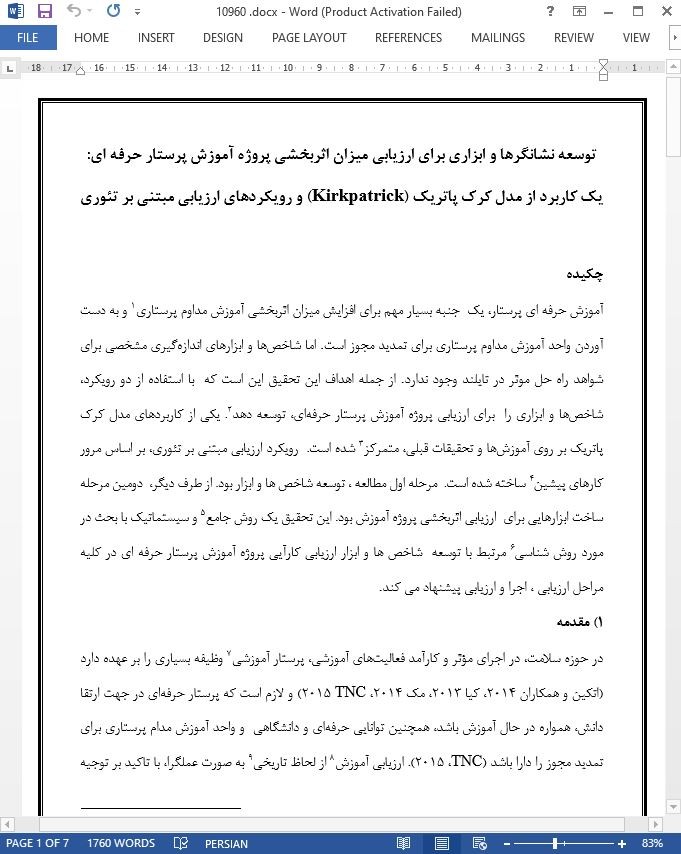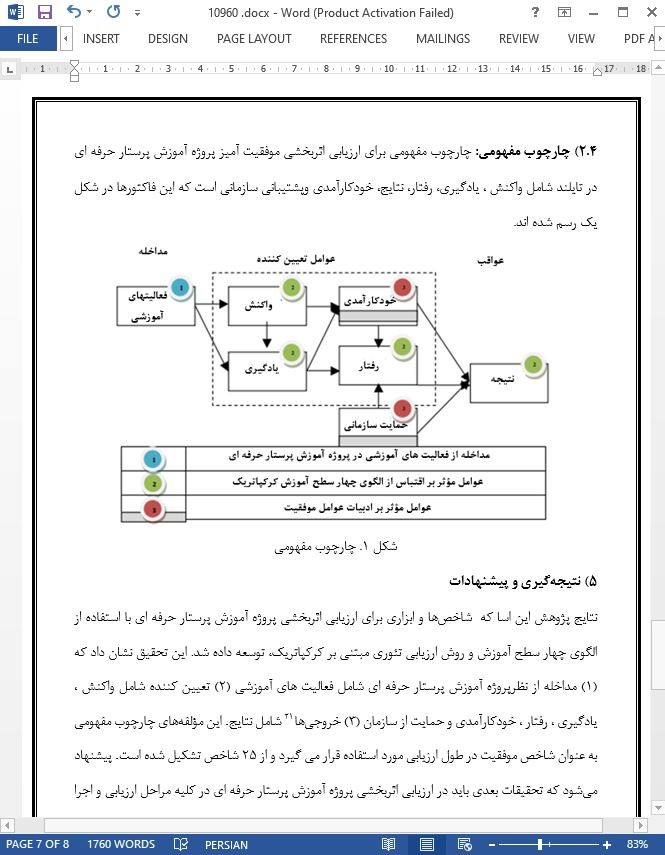
توسعه نشانگرها و ابزاری برای ارزیابی میزان اثربخشی پروژه آموزش پرستار حرفه ای
چکیده
آموزش حرفه ای پرستار، یک جنبه بسیار مهم برای افزایش میزان اثربخشی آموزش مداوم پرستاری و به دست آوردن واحد آموزش مداوم پرستاری برای تمدید مجوز است. اما شاخصها و ابزارهای اندازهگیری مشخصی برای شواهد راه حل موثر در تایلند وجود ندارد. از جمله اهداف این تحقیق این است که با استفاده از دو رویکرد، شاخصها و ابزاری را برای ارزیابی پروژه آموزش پرستار حرفهای، توسعه دهد . یکی از کاربردهای مدل کرک پاتریک بر روی آموزشها و تحقیقات قبلی، متمرکز شده است. رویکرد ارزیابی مبتنی بر تئوری، بر اساس مرور کارهای پیشین ساخته شده است. مرحله اول مطالعه ، توسعه شاخص ها و ابزار بود. از طرف دیگر، دومین مرحله ساخت ابزارهایی برای ارزیابی اثربخشی پروژه آموزش بود. این تحقیق یک روش جامع و سیستماتیک با بحث در مورد روش شناسی مرتبط با توسعه شاخص ها و ابزار ارزیابی کارآیی پروژه آموزش پرستار حرفه ای در کلیه مراحل ارزیابی ، اجرا و ارزیابی پیشنهاد می کند.
۱) مقدمه
در حوزه سلامت، در اجراي مؤثر و كارآمد فعاليتهای آموزشی، پرستار آموزشی وظيفه بسياری را بر عهده دارد (اتکین و همکاران ۲۰۱۴، کیا ۲۰۱۳، مک ۲۰۱۴، TNC ۲۰۱۵) و لازم است که پرستار حرفهای در جهت ارتقا دانش، همواره در حال آموزش باشد، همچنین توانایی حرفهای و دانشگاهی و واحد آموزش مدام پرستاری برای تمدید مجوز را دارا باشد (TNC، ۲۰۱۵). ارزيابی آموزش از لحاظ تاريخی به صورت عملگرا، با تاكيد بر توجيه مالی ، کیفیت و محتوای آموزش بوده است (دیویارانجانی و راجاسکار ۲۰۱۴، لی کلی و بلکمن ۲۰۱۲). متاسفانه آموزشهای ثانویه نتوانستهاند موفقیت و اثربخشی به دست آورند.. بنابراین، این آموزش فایده ای ندارد و باید از آن برای ارزیابی آموزشها به منظور کاهش هدررفتگی استفاده کرد. اهداف پژوهش نیاز دارد که شاخصها و ابزاری را توسعه دهد که بتواند بر اساس آنها ارزیابی کند که آیا می تواند برای ذینفعان بخاطر اثربخشی موفقیت آمیز اجرای این برنامه در آموزش خود مفید باشد یا نه.
۵) نتیجهگیری و پیشنهادات
نتایج پژوهش این اسا که شاخصها و ابزاری برای ارزیابی اثربخشی پروژه آموزش پرستار حرفه ای با استفاده از الگوی چهار سطح آموزش و روش ارزیابی تئوری مبتنی بر کرکپاتریک، توسعه داده شد. این تحقیق نشان داد که (۱) مداخله از نظرپروژه آموزش پرستار حرفه ای شامل فعالیت های آموزشی (2) تعیین کننده شامل واکنش ، یادگیری ، رفتار ، خودکارآمدی و حمایت از سازمان (3) خروجیها شامل نتایج. این مؤلفههای چارچوب مفهومی به عنوان شاخص موفقیت در طول ارزیابی مورد استفاده قرار می گیرد و از 25 شاخص تشکیل شده است. پیشنهاد میشود که تحقیقات بعدی باید در ارزیابی اثربخشی پروژه آموزش پرستار حرفه ای در کلیه مراحل ارزیابی و اجرا متمرکز شود.
Abstract
Professional nurse training is very important aspect for enhancing the effectiveness of continuing nursing education and to accumulate continuing nursing education unit for the renew of license; however, there are no specific the indicators and the measure instruments for the effective solution evidence in Thailand. The purposes of this research sought to develop the indicators and instrument to evaluate the effectiveness of the professional nurse training project, by using two approaches. An application of Kirkpatrick’s model focused on training and previous researches. Theory-based evaluation approach was built from literature reviews. The first phase of the study was the developing of the indicators and instrument, on the other hand of the second phase was the building instrument to evaluation effectiveness of training project and testing. This research proposes a comprehensive and systematic approach with a discussion of methodology related to developing of the indicators and instrument to evaluate on the professional nurse training project effectiveness in all steps of assessment, implementation and evaluation.
1. Introduction
The training nurse assumes great responsibility in the effective and efficient implementation of the educational activities in health care (Atkins et al., 2014; Kaya Işik & Çalişkan, 2013; Mack, 2014; TNC, 2015) and professional nurse necessary to be on training for enhancement knowledge, professional or academic ability and accumulation continuing nursing education unit to renew license (TNC, 2015). Assessing training has historically been operationally oriented, emphasizing financial justification, content and quality of the training rather than the potential of improved project performance or organizational transformation (Divyaranjani & Rajasekar, 2014; Lee-Kelley, & Blackman, 2012). Unfortunately, post-training is not have tracked the success or effectiveness. Or even with the rate is usually assessed after training without monitoring behavior in workplace of trainees. Therefore, this training has not worth and it should be used to evaluate the training accordingly to reduce waste. Research aims needed to develop of the indicators and instrument to evaluate that it could be helpful and fruitful to stakeholders for their successful effectiveness of the implementation on their own training.
5. Conclusion and recommendations
Research results was the development of the indicators and instrument to evaluate the effectiveness of the professional nurse training project by application of Kirkpatrick’s four level model of training and theory-based evaluation approaches. Research found that (1) the intervention in terms of the professional nurse training project including educational activities (2) the determinant including reaction, learning, behavior, self-efficacy, and organization support (3) the outcomes including results. These components of the conceptual framework will be used as the indicators of success in term of the evaluation, and will consist of 25 indicators. The further research should be focused on the evaluation of the effectiveness of the professional nurse training project in all steps of assessment, implementation and evaluation.
چکیده
۱) مقدمه
۲) مرور کارهای پیشین
۱.۲) ارزیابی برنامه های آموزشی
۲.۲) ارزیابی مبتنی بر تئوری
۲.۳) طراحی اثربخشی ارزیابی جنبه های پروژه آموزش پرستار حرفه ای
۳) روش تحقیق
۴) نتایج تحقیق
۱.۴) شاخصهای موفقیت پروژه آموزش پرستار حرفهای
۲.۴) چارچوب مفهومی
۵) نتیجهگیری و پیشنهادات
Abstract
1. Introduction
2. Literature Reviews
2.1 Evaluating training programs
2.2 Theory-based evaluation
2.3 Design of evaluation effectiveness of the professional nurse training project aspects
3. Research Methodology
4. Research results
4.1 Professional nurse training project success indicators
4.2 Conceptual framework
5. Conclusion and recommendations
- اصل مقاله انگلیسی با فرمت ورد (word) با قابلیت ویرایش
- ترجمه فارسی مقاله با فرمت ورد (word) با قابلیت ویرایش، بدون آرم سایت ای ترجمه
- ترجمه فارسی مقاله با فرمت pdf، بدون آرم سایت ای ترجمه



